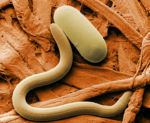Nematode Life Cycle
General Life-Cycle
In the complete nematode life cycle there are four larval stages, followed by the immature adult.
egg → L1 → L2 → L3 → L4 → adult
The direct life cycle is the most common. The free living larval stages undergoes two transformations after hatching. Infection occurs when the host ingests the free L3.
The indirect life cycle involves an intermediate host. The first two moults usually occur in the intermediate host. Infection of the definitive host is either via ingestion of the intermediate host or by inoculation of the L3 by an intermediate host such as an insect.
Nematode Eggs
These vary greatly in appearance and are very useful for diagnosis as they can often be detected and counted in faecal samples NOTE: we use the typical strongyle egg to provide us with a yard-stick for comparing sizes. A "large egg", for example, means larger than a strongyle egg. A typical strongyle egg is approximately 80µm long.
| Nematode Life Cycle Learning Resources | |
|---|---|
To reach the Vetstream content, please select |
Canis, Felis, Lapis or Equis |
 Search for recent publications via CAB Abstract (CABI log in required) |
Nematode Life Cycle publications |
| This article has been peer reviewed but is awaiting expert review. If you would like to help with this, please see more information about expert reviewing. |
Error in widget FBRecommend: unable to write file /var/www/wikivet.net/extensions/Widgets/compiled_templates/wrt664a0c0926ffd2_29907782 Error in widget google+: unable to write file /var/www/wikivet.net/extensions/Widgets/compiled_templates/wrt664a0c092ab551_32470924 Error in widget TwitterTweet: unable to write file /var/www/wikivet.net/extensions/Widgets/compiled_templates/wrt664a0c092e0f31_31143713
|
| WikiVet® Introduction - Help WikiVet - Report a Problem |
